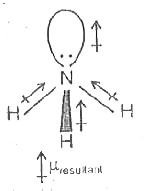From each of the following pairs, select the molecule with higher value of the property mentioned
against each pair :
NH3,PH3: bond angle
(ii)NF3,NH3 : dipole moment
(iii) MgO,CaO: hardness
(iv) HCl, HBr : ionic character
Let's solve the question step by step.
Step 1: Compare NH₃ and PH₃ for bond angle
- NH₃ (Ammonia) has a trigonal pyramidal shape due to the presence of a lone pair on nitrogen. The bond angle in NH₃ is approximately 107 degrees.
- PH₃ (Phosphine) has a similar structure but with phosphorus, which is larger and less electronegative than nitrogen. The bond angle in PH₃ is around 93.5 degrees.
Conclusion: NH₃ has a higher bond angle than PH₃.
Step 2: Compare NF₃ and NH₃ for dipole moment
- NF₃ (Nitrogen trifluoride) has three fluorine atoms, which are highly electronegative. The dipole moments of the N-F bonds point towards fluorine, but due to the symmetry of the molecule, the dipole moments partially cancel out.
- NH₃ (Ammonia) has a lone pair on nitrogen and the dipole moments of the N-H bonds point towards nitrogen, resulting in a net dipole moment.
Conclusion: NH₃ has a higher dipole moment than NF₃.
Step 3: Compare MgO and CaO for hardness
- MgO (Magnesium oxide) is known to be harder than CaO (Calcium oxide) due to the smaller size of the magnesium ion compared to the calcium ion. The smaller size leads to a stronger ionic bond in MgO, making it harder.
Conclusion: MgO is harder than CaO.
Step 4: Compare HCl and HBr for ionic character
- HCl (Hydrochloric acid) has a greater electronegativity difference between hydrogen and chlorine compared to the difference between hydrogen and bromine in HBr. This greater difference results in a higher ionic character for HCl.
Conclusion: HCl has a higher ionic character than HBr.
Final Answers:
1. NH₃ (higher bond angle)
2. NH₃ (higher dipole moment)
3. MgO (higher hardness)
4. HCl (higher ionic character)
---
- NH₃ (Ammonia) has a trigonal pyramidal shape due to the presence of a lone pair on nitrogen. The bond angle in NH₃ is approximately 107 degrees.
- PH₃ (Phosphine) has a similar structure but with phosphorus, which is larger and less electronegative than nitrogen. The bond angle in PH₃ is around 93.5 degrees.
- NF₃ (Nitrogen trifluoride) has three fluorine atoms, which are highly electronegative. The dipole moments of the N-F bonds point towards fluorine, but due to the symmetry of the molecule, the dipole moments partially cancel out.
- NH₃ (Ammonia) has a lone pair on nitrogen and the dipole moments of the N-H bonds point towards nitrogen, resulting in a net dipole moment.
- MgO (Magnesium oxide) is known to be harder than CaO (Calcium oxide) due to the smaller size of the magnesium ion compared to the calcium ion. The smaller size leads to a stronger ionic bond in MgO, making it harder.
- HCl (Hydrochloric acid) has a greater electronegativity difference between hydrogen and chlorine compared to the difference between hydrogen and bromine in HBr. This greater difference results in a higher ionic character for HCl.
1. NH₃ (higher bond angle)
2. NH₃ (higher dipole moment)
3. MgO (higher hardness)
4. HCl (higher ionic character)
Topper's Solved these Questions
- CHEMICAL BONDING AND MOLECULAR STRUCTUREBook:PRADEEPChapter:CHEMICAL BONDING AND MOLECULAR STRUCTUREExercise:NCERT Questions And Exercises With Answers
Explore 39 Videos
- CHEMICAL BONDING AND MOLECULAR STRUCTUREBook:PRADEEPChapter:CHEMICAL BONDING AND MOLECULAR STRUCTUREExercise:NCERT EXAMPLAR PROBLEMS (MULTIPLE CHOICE QUESTIONS -I)
Explore 22 Videos
- CHEMICAL BONDING AND MOLECULAR STRUCTUREBook:PRADEEPChapter:CHEMICAL BONDING AND MOLECULAR STRUCTUREExercise:TEST YOUR GRIP (FILL IN THE BLANKS II)
Explore 20 Videos
- APPENDIXBook:PRADEEPChapter:APPENDIXExercise:MODEL TEST PAPER <br> (Section C )
Explore 9 Videos
- CLASSIFICATION OF ELEMENTS AND PERIODICITY IN PROPERTIES Book:PRADEEPChapter:CLASSIFICATION OF ELEMENTS AND PERIODICITY IN PROPERTIES Exercise:Competition Focus (Jee Main and Advanced / Medical Entrance ) ( Assertion - Reason Type Question ) (Type II)
Explore 12 Videos
Similar Questions
From the following pair, select the inolecule with the higher value of the property mentioned against them : (Justify your answer as well)
H2O,H2S : Bond angle
View SolutionFrom the following pair, select the inolecule with the higher value of the property mentioned against them : (Justify your answer as well)
N2,O2 : Bond energy
View Solution
Knowledge Check
Which of the following is correct representation of dipole moment of NH3 molecule?
A B
B C
C DNH3 being symmetrical will not show dipole moment
DNH3 being symmetrical will not show dipole moment
From the following pair, select the inolecule with the higher value of the property mentioned against them : (Justify your answer as well)
C−C,C=C,C≡C : Bond length
View SolutionFrom the following pair, select the stronger base:
CH3CN or CH3CH2NH2
View SolutionIn each of the following pairs, predict which has higher value of the property mentioned:
(i)HF,HCl:Polar character(ii)NH3,H2O:Bond angle(iii)KCl,KF:Lattice enthalpy(iv)NF3,NH3:Dipole moment(v)C2H2,C2H4:s - character in the hybridisation of carbon
View SolutionWhich out of NH3andNF3 has higher dipole moment and why?
View SolutionSelect the molecule or ion having larger property mentioned in each of the following pairs :
(a)NF3,NH3:dipole moment(b)NH3,PH3:bond angle(c)CO3,BF3:bond angle
View SolutionWhich one of each of the following pairs is expected have the larger bond angle ?
(1) H2OandNH3 (2) SF2andBeF2
(3) BF3andBF−4 (4) PH3andNH3
(5) NH3andNF3
View SolutionGive the decreasing order of the property mentioned against each of the following
C2H2,BF3,H2O,NH3,CH4 (bond angle)
(b) NH3,ΘNH2,⊕NH4 (bond angle)
( c) K−F,Li−CI,Na−I,Br−H,F−H,C−H (ionic character)
(d) NH3,PH3 (bond angle)
(e) NF3,NH3 (dipole mement)
(f) CH3CI,CH2CI2,CHCI3,CCI4 (dipole moment)
(g) MgO,CaO (hardness)
(h) HCI,HBr (ionic characacter)
(i) NO2,NO⊕2NOΘ2 (bond angle)
(j) CI2,O2,F2,N2 (bond strenght)
(k) O,N,F,CI,S (strength of H - bonging)
(I) N2,N⊕2,NΘ2,N2−2 (order of stability)
(m) O2+2,O2,O⊕2,OΘ2O2−2 (order of stability)
(n) N2,F2,O2,H2 (bond lenght) .
View Solution

